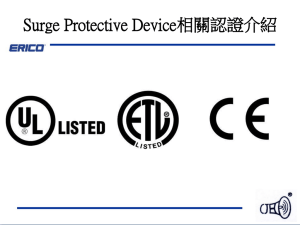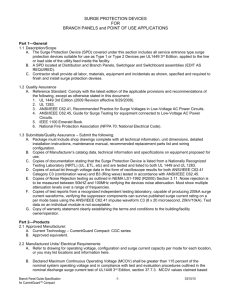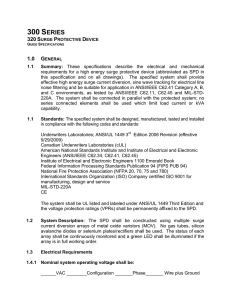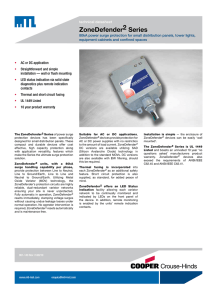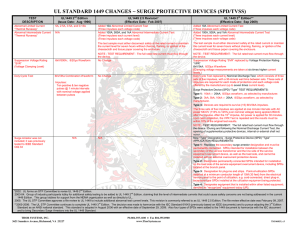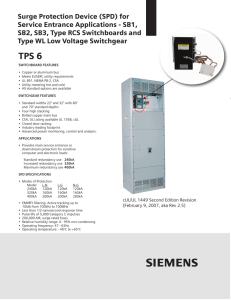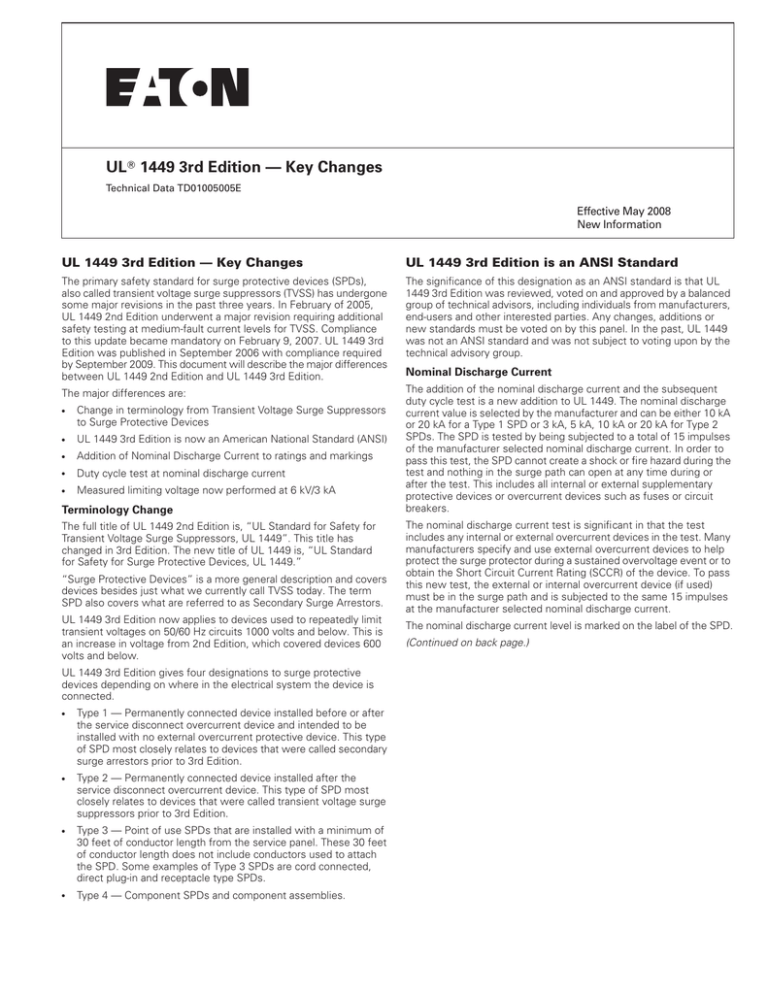
UL 1449 3rd Edition — Key Changes
Technical Data TD01005005E
Effective May 2008
New Information
UL 1449 3rd Edition — Key Changes
UL 1449 3rd Edition is an ANSI Standard
The primary safety standard for surge protective devices (SPDs),
also called transient voltage surge suppressors (TVSS) has undergone
some major revisions in the past three years. In February of 2005,
UL 1449 2nd Edition underwent a major revision requiring additional
safety testing at medium-fault current levels for TVSS. Compliance
to this update became mandatory on February 9, 2007. UL 1449 3rd
Edition was published in September 2006 with compliance required
by September 2009. This document will describe the major differences
between UL 1449 2nd Edition and UL 1449 3rd Edition.
The significance of this designation as an ANSI standard is that UL
1449 3rd Edition was reviewed, voted on and approved by a balanced
group of technical advisors, including individuals from manufacturers,
end-users and other interested parties. Any changes, additions or
new standards must be voted on by this panel. In the past, UL 1449
was not an ANSI standard and was not subject to voting upon by the
technical advisory group.
The major differences are:
The addition of the nominal discharge current and the subsequent
duty cycle test is a new addition to UL 1449. The nominal discharge
current value is selected by the manufacturer and can be either 10 kA
or 20 kA for a Type 1 SPD or 3 kA, 5 kA, 10 kA or 20 kA for Type 2
SPDs. The SPD is tested by being subjected to a total of 15 impulses
of the manufacturer selected nominal discharge current. In order to
pass this test, the SPD cannot create a shock or fire hazard during the
test and nothing in the surge path can open at any time during or
after the test. This includes all internal or external supplementary
protective devices or overcurrent devices such as fuses or circuit
breakers.
●
Change in terminology from Transient Voltage Surge Suppressors
to Surge Protective Devices
●
UL 1449 3rd Edition is now an American National Standard (ANSI)
●
Addition of Nominal Discharge Current to ratings and markings
●
Duty cycle test at nominal discharge current
●
Measured limiting voltage now performed at 6 kV/3 kA
Terminology Change
The full title of UL 1449 2nd Edition is, “UL Standard for Safety for
Transient Voltage Surge Suppressors, UL 1449”. This title has
changed in 3rd Edition. The new title of UL 1449 is, “UL Standard
for Safety for Surge Protective Devices, UL 1449.”
“Surge Protective Devices” is a more general description and covers
devices besides just what we currently call TVSS today. The term
SPD also covers what are referred to as Secondary Surge Arrestors.
UL 1449 3rd Edition now applies to devices used to repeatedly limit
transient voltages on 50/60 Hz circuits 1000 volts and below. This is
an increase in voltage from 2nd Edition, which covered devices 600
volts and below.
UL 1449 3rd Edition gives four designations to surge protective
devices depending on where in the electrical system the device is
connected.
●
●
●
●
Type 1 — Permanently connected device installed before or after
the service disconnect overcurrent device and intended to be
installed with no external overcurrent protective device. This type
of SPD most closely relates to devices that were called secondary
surge arrestors prior to 3rd Edition.
Type 2 — Permanently connected device installed after the
service disconnect overcurrent device. This type of SPD most
closely relates to devices that were called transient voltage surge
suppressors prior to 3rd Edition.
Type 3 — Point of use SPDs that are installed with a minimum of
30 feet of conductor length from the service panel. These 30 feet
of conductor length does not include conductors used to attach
the SPD. Some examples of Type 3 SPDs are cord connected,
direct plug-in and receptacle type SPDs.
Type 4 — Component SPDs and component assemblies.
Nominal Discharge Current
The nominal discharge current test is significant in that the test
includes any internal or external overcurrent devices in the test. Many
manufacturers specify and use external overcurrent devices to help
protect the surge protector during a sustained overvoltage event or to
obtain the Short Circuit Current Rating (SCCR) of the device. To pass
this new test, the external or internal overcurrent device (if used)
must be in the surge path and is subjected to the same 15 impulses
at the manufacturer selected nominal discharge current.
The nominal discharge current level is marked on the label of the SPD.
(Continued on back page.)
Measured Limiting Voltage Test
The measured limiting voltage test in UL 1449 3rd Edition uses a 6
kV/3 kA combination wave surge to determine the Voltage Protection
Rating (VPR) of the SPD. This test is similar to the Suppressed Voltage Rating (SVR) as performed in UL 1449 2nd Edition. The key difference between the tests in 2nd Edition and 3rd Edition is that the
magnitude of the current used for the test is six times greater in 3rd
Edition versus 2nd Edition. This much higher current level will mean
that the measured limiting voltage will likely be significantly higher for
the higher current level. For example, the VPR for an SPD will likely
be much higher than the SVR of an identical SPD. With higher current
levels come higher limiting voltages.
It is important that users are familiar with the difference in testing
methods and the subsequent effect on the value of the VPR. Without
considering or understanding the differences in the level of currents
used in the test, one might assume that a UL 1449 3rd Edition device
with a VPR of 700 volts has a higher limiting voltage than a UL 1449
2nd Edition device with an SVR of 400 volts. Such a conclusion would
be inaccurate. The higher VPR rating of 700 volts is likely caused by
the higher level of surge current during the measured limiting voltage
test. In order to make an accurate assessment of devices, the VPR
rating of one device must be compared with the VPR rating of
another device. Comparing a VPR rating to an SVR rating yields no
useful or conclusive information.
There are many other changes and updates within UL 1449 3rd Edition. This document has summarized the most significant changes to
the UL 1449 standard. Understanding the key changes in UL 1449 is
important for end users, installers and specifiers of Surge Protective
Devices.
UL is a registered trademark of Underwriters Laboratories Inc.
Eaton Corporation
Electrical Group
1000 Cherrington Parkway
Moon Township, PA 15108
United States
877-ETN-CARE (877-386-2273)
Eaton.com
© 2008 Eaton Corporation
All Rights Reserved
Printed in USA
Publication No. TD01005005E / Z7076
May 2008

